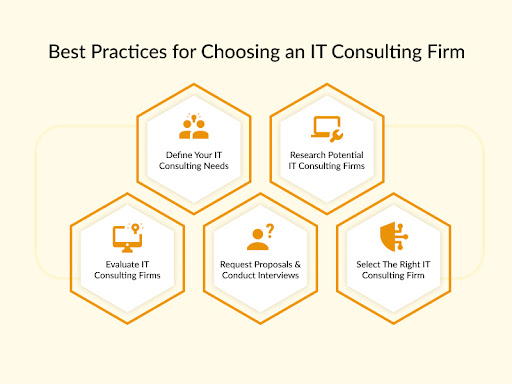In this digital age, startups are emerging at an unprecedented rate, and technology has become an essential part of every business. However, not all startups have the expertise or resources to navigate the complex world of IT on their own. That’s where IT consulting firms come in.
According to Statista, the IT Consulting & Implementation segment is expected to generate a revenue of US$65.36bn by 2023.
IT consulting firms help startups identify the right technology solutions, implement them effectively, and manage them efficiently.
Choosing the right IT consulting firm is crucial for startups as it can make or break their success. With so many options, knowing what to look for and where to start can be challenging.
That’s why we have curated this blog to help startups unlock the best practices for choosing an IT consulting firm.

1. Choose The Right IT Consulting Firm
Choosing the right IT consulting firm is critical for ensuring the success of your IT initiatives. A good IT consulting firm can help you:
- Improve your IT infrastructure and operations.
- Enhance your cybersecurity posture.
- Develop and implement custom software solutions.
- Stay up-to-date with the latest tools and technologies.
- Achieve your IT goals and objectives.
Moreover, many companies outsource their software development needs to offshore software development services to reduce costs and gain access to specialized talent.
Selecting the right IT consulting firm is crucial. Here are some best practices to help you do just that.
2. Define Your IT Consulting Needs
Before choosing an IT consulting firm, defining your IT consulting needs is essential.
A. Assess Your Current IT Infrastructure
It will help you identify gaps or deficiencies in your current system and determine what services and solutions you require from an IT consulting firm.
The key areas to consider when assessing your current IT infrastructure include the following:
- Hardware and software: To determine if they meet your business requirements.
- Network and security: To identify any vulnerabilities or weaknesses that must be addressed.
- Data management: To manage and store your data effectively.
- Technical support: To identify any areas where you need additional support
B. Identify Your IT Goals & Objectives
The key areas to consider are:
- Business strategy: Determine how IT can support your overall business strategy and goals.
- Operational efficiency: Identify areas where IT can improve your business operations and processes.
- Innovation: Determine how IT can help drive innovation and new business opportunities.
- Risk management: Identify areas where IT can help mitigate risks and protect your business from potential threats.
3. Research Potential IT Consulting Firms
Once you’ve defined your IT consulting needs, it’s time to research potential IT consulting firms. Some best practices to follow include:
1. Understanding the different types of IT consulting firms, such as:
- Full-service consulting firms that offer a wide range of IT services.
- Specialized consulting firms that focus on specific areas of IT, such as cybersecurity, cloud computing, or custom software development.
- Boutique consulting firms that provide customized solutions for specific industries or business functions.
2. Reviewing industry reports and rankings to identify top-performing firms.
3. Soliciting recommendations from peers and industry experts.
4. Research IT consulting firms online, including their websites, social media profiles, and online reviews.
Following these practices can create a shortlist of potential IT consulting firms to evaluate further.
4. Evaluate IT Consulting Firms
The next step is to evaluate the shortlisted IT consulting firms. Some best practices to follow include:
- Assessing the IT consulting firm’s experience and expertise, including their track record of successful engagements.
- Evaluating the IT consulting firm’s credentials and certifications, such as their Microsoft Partner status or ISO certifications.
- Reviewing the IT consulting firm’s track record and references, including client testimonials and case studies.
- Reviewing the IT consulting firm’s project management approach, including their communication protocols and quality assurance measures.
Startups looking to stay competitive in today’s market should hire IT consulting services to help them navigate the complex and ever-changing technology landscape.
5. Request Proposals & Conduct Interviews
After identifying a list of potential IT consulting firms, the next step is to request detailed proposals from the shortlisted firms. Let’s take a look at some best practices to consider when requesting proposals:
- Clearly define the scope: Be specific about the project’s goals, timeline, budget, and other essential details.
- Request a detailed breakdown of the proposal: Ask them to provide a detailed breakdown of their proposed solution, including the methodology, tools, and resources required.
- Request pricing details: Ask them to provide a detailed pricing structure that includes all costs, such as hourly rates, fixed fees, and additional expenses.
Once you have received the proposals, it’s time to conduct initial interviews with the shortlisted firms. Let’s go through some best practices for the interview process:
- Discuss the proposal in detail: Use the proposal as a starting point for the discussion and ask the IT consulting firm to explain their proposed solution in more detail.
- Evaluate the IT consulting firm’s suitability: You can ask about their past projects, their team’s qualifications, and their approach to project management.
- Discuss communication and collaboration: Ask about their communication channels, project updates, and collaboration tools to ensure you can work together effectively.
Before making a final decision, requesting client references and case studies from IT consulting firms is important. It will help you evaluate their track record and ability to deliver results.
6. Select The Right IT Consulting Firm
Once you have completed your due diligence and identified the IT consulting firms that align with your requirements and budget, it is time to select the right IT consulting firm. It involves:
1. Evaluating The Proposal & Pricing
- Evaluate the proposal: To ensure that it meets all of your requirements. It includes assessing the scope of work, timelines, and deliverables.
- Understand the pricing: Understand the pricing structure and ensure it is transparent and aligned with your budget.
- Assess the value: Assess the proposal’s value and pricing to ensure you get the best value for your money.
2. Reviewing The Contract & Negotiating Terms
- Review the contract: Carefully review it and ensure it aligns with the proposal and your requirements.
- Negotiate terms: Negotiate any terms that are not aligned with your requirements or that you are uncomfortable with.
- Seek legal advice: Seek legal advice if necessary to ensure the contract is fair and protects your interests.
3. Finalizing The Engagement & Kicking Off The Project
- Finalize the engagement: By signing the contract and ensuring all parties know the scope of work, timelines, and deliverables.
- Establish communication channels: Establish clear communication channels to ensure you are updated on the project’s progress.
- Kick off the project: To ensure everyone is aligned on the project objectives and timelines.
By following these practices, you can ensure that you choose the right firm that can complete your project successfully.
Final Words
With these best practices, you can confidently select an IT consulting firm to help you achieve your project goals and drive your business forward.
Therefore, when looking to streamline your IT operations, it’s crucial to carefully evaluate and hire software & technology consulting services that align with your specific goals and objectives.












